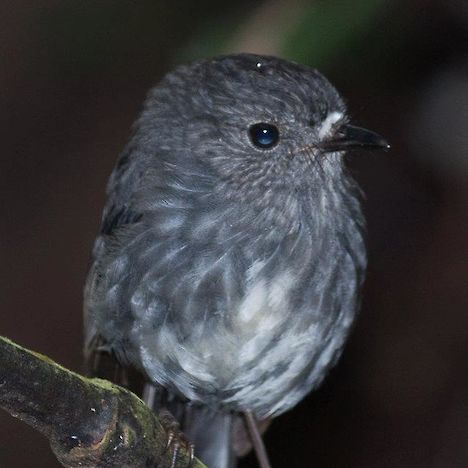Other names:
New Zealand robin, toutouwai, bush robinThreat category:
At Risk: Declining?Regions:
Northland, Auckland, Waikato, Bay of Plenty, Gisborne, Hawkes Bay, Manawatu-Wanganui, Taranaki, WellingtonDistribution:
Largely restricted to the central North Island from Taranaki through to the Bay of Plenty, and Little Barrier and Kapiti islands. However, numerous translocations to offshore islands, mainland sanctuaries, and other areas with intensive pest control have seen the distribution extended from Northland to Wellington.
Description
- A small, insectivorous bird, larger than a house sparrow, and standing tall on long legs.
- Light grey to dark grey. A white patch on lower chest area.
- Often very inquisitive, approaching people to within a few metres, and sometimes much closer.
Interesting Facts
- The North Island robin (Petroica longipes; At Risk-Declining) is a species in its own right. In the south, two subspecies of robin are present; South Island robin (Petroica australis australis; At Risk-Declining), and Stewart Island robin (Petroica australis rakiura; At Risk-Relict).
- North Island and South Island robins have both been classified as Not Threatened for many years, but in 2017 their classification was changed to At Risk-Declining, on the basis of ongoing declines of mainland populations.
- The North Island robin is often patchily distributed, with populations absent from areas that appear suitable.
- The South Island robin is particularly patchy through the central West Coast region, but more widely distributed through Fiordland and in the northern West Coast into Nelson-Marlborough.
Association with Plantations
- North Island robin are well known from exotic plantation forests, particularly more mature plantations with a subcanopy of indigenous shrubs. Robins from plantation forestry areas have been used in translocations to other areas in the North Island. The possibility that such plantation forests maintain self-sustaining and and stable populations of robins is of considerable ecological interest given the species has disappeared many areas of the North Island, and is now considered to be in national decline.
- South Island robins are also known from exotic plantation forests.
Threats
- A combination of predation of eggs, young and adults, particularly females, by mustelids, cats, possums, and arboreal ship rats is the key threat affecting both North and South Island robins. The loss of females to predation results in male-biased populations.
- Intensive pest control can lead to significant increases in the population within a matter of a few years.
- In the North Island, research has shown that North Island robin populations can benefit from control of ship rats alone. However, stoats have been shown to be a significant predator for some South Island robin populations.
Management Options and Methods
- Undertake pest control if breeding populations are present in pine plantations to target rats, possums and stoats. Obtain advice on the most appropriate methods.
Monitoring Options
- Database of sightings, nest locations, protection methods and breeding outcomes.
- Undertake five-minute bird counts, or acoustic monitoring (obtain advice on survey design).
- Report findings to DOC.
Further Information and Support
- New Zealand Birds Online: North Island robin, South Island robin.
- Department of Conservation species accounts: New Zealand robin.
- Heather and Robertson 2000. The Field Guide to the Birds of New Zealand. Viking. 440 pp.
- Pest management: DOC, Regional Councils.


